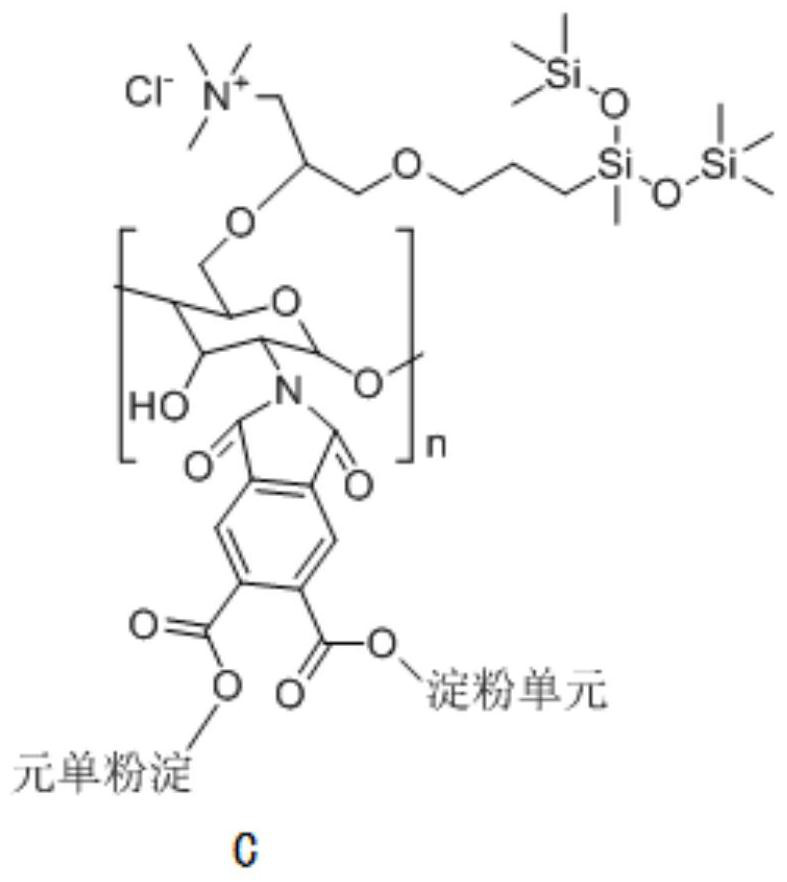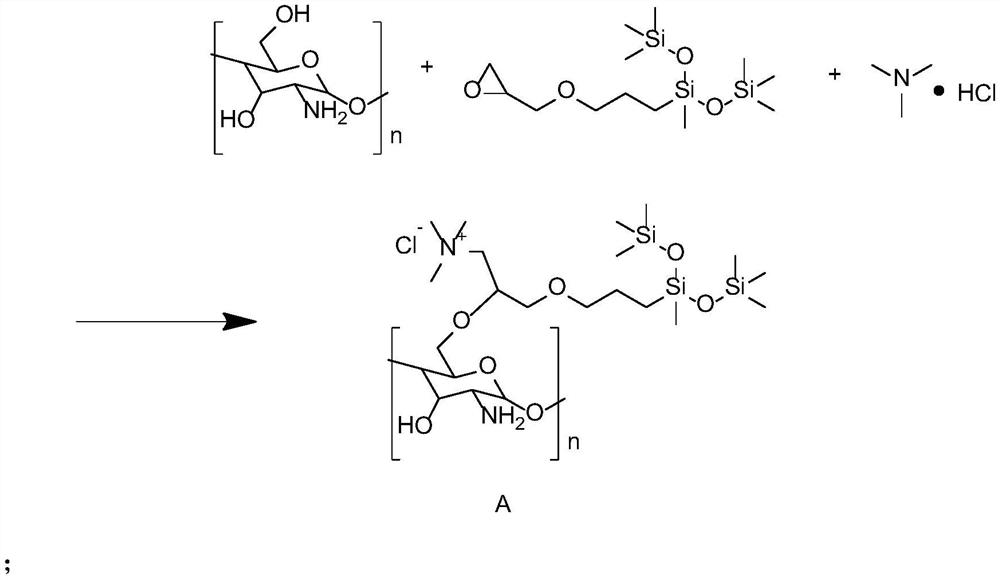Preparation method of printing adhesive for digital printing
A digital printing and adhesive technology, applied in the field of digital printing, can solve the problems of pigment ink flocculation, precipitation, ink nozzle agglomeration, etc.
- Summary
- Abstract
- Description
- Claims
- Application Information
AI Technical Summary
Problems solved by technology
Method used
Image
Examples
Embodiment 1
[0034] The preparation method of the printing adhesive that is used for digital printing specifically comprises the following steps:
[0035] S1, preparation of epoxy trisiloxane
[0036] 11mol heptamethyltrisiloxane, 10mol allyl glycidyl ether, 100ml solvent ethylene glycol dimethyl ether and 5mmol catalyst Ni(CO) 4 Add it into the reaction flask, reflux reaction for 6h, and obtain epoxy trisiloxane through hydrosilylation reaction, the reaction formula is as follows:
[0037]
[0038] S2, preparation of antibacterial dispersant
[0039] After mixing 1kg chitosan and 6mol trimethylamine hydrochloride evenly, put it into the epoxy trisiloxane prepared by S1, add 120ml acid catalyst, and the acid catalyst is SnCl 4 Mixture with 20% hydrochloric acid aqueous solution in the ratio of 1mg:18ml; heated to 75°C for ring-opening reaction for 3h, the antibacterial dispersant of formula A structure is obtained; wherein the deacetylation degree of chitosan powder is 85%-99 %;
[...
Embodiment 2
[0052] The preparation method of the printing adhesive that is used for digital printing specifically comprises the following steps:
[0053] S1, preparation of epoxy trisiloxane
[0054] 12mol heptamethyltrisiloxane, 10mol allyl glycidyl ether, 100ml solvent ethylene glycol dimethyl ether and 7mmol catalyst Ni(CO) 4 Add it into the reaction flask, reflux reaction for 7h, and obtain epoxy trisiloxane through hydrosilylation reaction, the reaction formula is as follows:
[0055]
[0056] S2, preparation of antibacterial dispersant
[0057] After mixing 1kg chitosan and 7mol trimethylamine hydrochloride evenly, put it into the epoxy trisiloxane prepared by S1, add 100ml acid catalyst, and the acid catalyst is SnCl 4 Mixture with 20% hydrochloric acid aqueous solution in the ratio of 1mg:20ml; heated to 85°C for ring-opening reaction for 4h, the antibacterial dispersant of formula A structure is obtained; wherein the degree of deacetylation of chitosan powder is 85%-99 %; ...
Embodiment 3
[0070] The preparation method of the printing adhesive that is used for digital printing specifically comprises the following steps:
[0071] S1, preparation of epoxy trisiloxane
[0072] 12mol heptamethyltrisiloxane, 10mol allyl glycidyl ether, 100ml solvent ethylene glycol dimethyl ether and 6mmol catalyst Ni(CO) 4 Add it into the reaction flask, reflux reaction for 7h, and obtain epoxy trisiloxane through hydrosilylation reaction, the reaction formula is as follows:
[0073]
[0074] S2, preparation of antibacterial dispersant
[0075] After mixing 1kg chitosan and 7mol trimethylamine hydrochloride evenly, put it into the epoxy trisiloxane prepared by S1, add 110ml acid catalyst, and the acid catalyst is SnCl 4 Mixture with 20% hydrochloric acid aqueous solution at a ratio of 1mg:19ml; heated to 70°C for ring-opening reaction for 3h, the antibacterial dispersant of formula A structure is obtained; wherein the deacetylation degree of chitosan powder is 85%-99 %;
[00...
PUM
 Login to View More
Login to View More Abstract
Description
Claims
Application Information
 Login to View More
Login to View More - R&D
- Intellectual Property
- Life Sciences
- Materials
- Tech Scout
- Unparalleled Data Quality
- Higher Quality Content
- 60% Fewer Hallucinations
Browse by: Latest US Patents, China's latest patents, Technical Efficacy Thesaurus, Application Domain, Technology Topic, Popular Technical Reports.
© 2025 PatSnap. All rights reserved.Legal|Privacy policy|Modern Slavery Act Transparency Statement|Sitemap|About US| Contact US: help@patsnap.com



